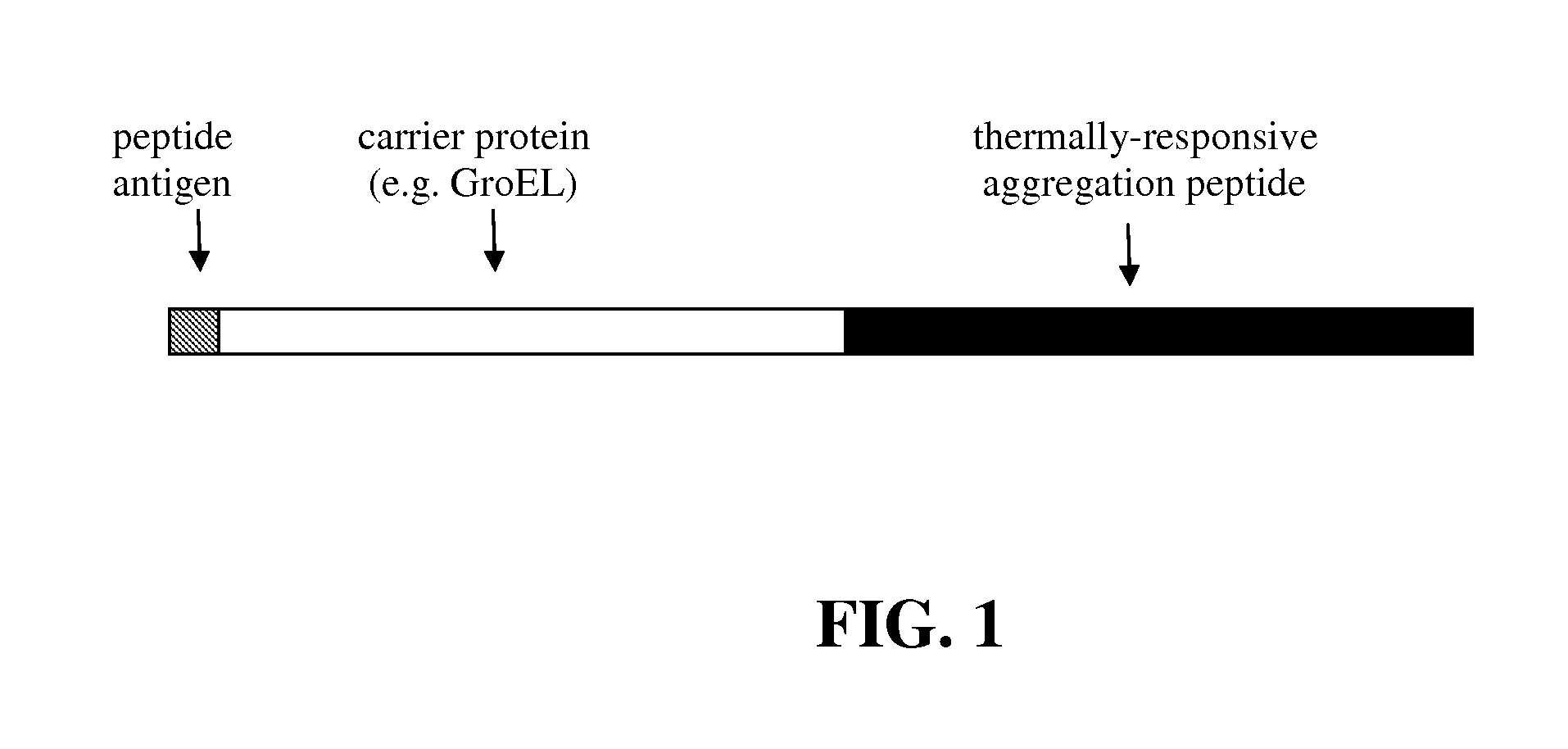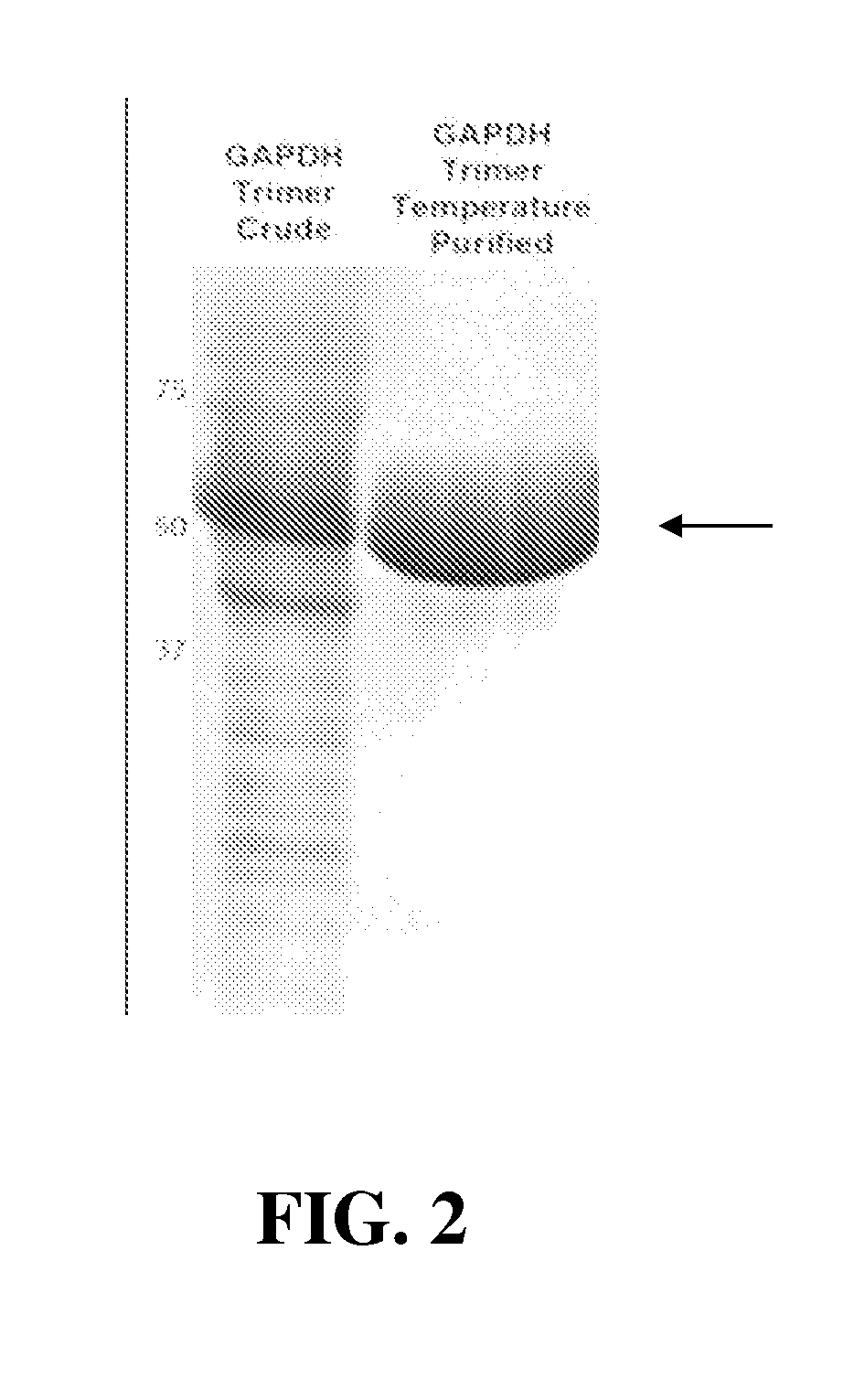Improved production of Anti-peptide antibodies
a technology of anti-peptide antibodies and anti-peptides, which is applied in the field of improved production of anti-peptide antibodies, can solve the problems of preventing researchers from performing these techniques with optimal sensitivity, affecting the effect of anti-peptide activity, and poor quality of commercial apas, so as to improve the anti-peptide activity, and facilitate purification and manipulation.
- Summary
- Abstract
- Description
- Claims
- Application Information
AI Technical Summary
Benefits of technology
Problems solved by technology
Method used
Image
Examples
example 1
Production of Recombinant Peptide Antigens Fused to Carrier Proteins Containing Thermally-Responsive Aggregation Peptides
[0036]A peptide antigen (40 residues; protein span Phe 158-Tyr197 from human procaspase-3) was expressed as a fusion protein with the thermally-responsive carrier protein (GroEL protein fused to a 21 kDa TRA polypeptide comprised of VPGVG and VPGFG pentapeptide subunits) using the following procedure. The 120 by DNA sequence encoding peptide antigen was synthesized and subcloned into the carrier protein expression vectors on the 5′ end of the carrier protein open reading frame encoding the E. coli GroEL protein fused at its C-terminus to the thermally-responsive aggregation peptide. The resulting expression plasmid was then transformed into the BL21 STAR E. coli expression strain. These cells were use to inoculate 100 ml bacterial cultures containing rich medium; the cells were grown at 37° C. When the culture density reached an OD 600≈1, the cultures were induced...
example 2
Production and Purification of Immunogenic Carrier Proteins Containing Thermally-Responsive Peptides
[0037]Thermally-responsive carrier-proteins (such as E. coli GAPDH (glyceraldehyde-3-phosphate dehydrogenase) protein fused to the N-terminus a 21 kDa TRA polypeptide using VPGVG and VPGFG pentapeptide subunits) were produced in bacterial cultures at 25° C. for 3 hours and then the cells were harvested by centrifugation at 4° C. and lysed on ice using a lysozyme / Triton X-100 buffer. After lysis and DNase treatment to reduce viscosity, the samples were centrifuged at 4° C. to remove cell debris. The resulting lysates were heated to 37° C. to precipitate the target protein and the samples were centrifuged at 10,000 rpm for 10 minutes at room temperature. The supernatant was removed from the protein pellet. The protein pellets could be redissolved in cold 1× PBS and then reprecipitated at 37° C. to further purify the proteins (FIG. 2). The protein was >90% pure as measured by SDS-PAGE a...
example 3
Production of Polyclonal Anti-Peptide Antibodies Using Recombinant Peptides Fused to Carrier Proteins Containing Thermally-Responsive Peptides
[0038]A DNA sequence encoding a peptide antigen from the caspase-3 (csp-3) protein was fused to the 5′ terminus of the open reading frame encoding GroEL carrier protein-TRA peptide (14 kDa (dimer) or 21 kDa (trimer) fusions (or GroEL carrier protein lacking TRA peptide as a control). The recombinant antigen-carrier proteins were expressed in bacteria and purified to homogeneity. The peptide antigen-carrier proteins were dialyzed into PBS buffer and, after mixing with Freund's Adjuvant, used to immunize rabbits to produce polyclonal antibodies (0.1 mg protein per rabbit). As a control, rabbits were immunized with the chemically conjugated csp3-KLH control. The rabbits were immunized using a standard protocol (initial immunization with Complete Freund's Adjuvant and 2 injections using Incomplete Freund's Adjuvant then the final 3 injections with...
PUM
| Property | Measurement | Unit |
|---|---|---|
| temperatures | aaaaa | aaaaa |
| temperatures | aaaaa | aaaaa |
| internal temperature | aaaaa | aaaaa |
Abstract
Description
Claims
Application Information
 Login to View More
Login to View More - R&D
- Intellectual Property
- Life Sciences
- Materials
- Tech Scout
- Unparalleled Data Quality
- Higher Quality Content
- 60% Fewer Hallucinations
Browse by: Latest US Patents, China's latest patents, Technical Efficacy Thesaurus, Application Domain, Technology Topic, Popular Technical Reports.
© 2025 PatSnap. All rights reserved.Legal|Privacy policy|Modern Slavery Act Transparency Statement|Sitemap|About US| Contact US: help@patsnap.com



